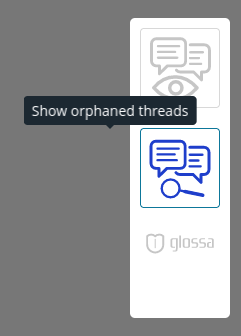Frequently Asked Questions
With what kind of web pages does glossa work?
Glossa keeps track of which parts of a page were commented by saving the CSS locator of the range that was selected when the first comment was created. Therefore, glossa works best if the content AND the internal structure of the web page where the comments are added doesn’t change over time.
What happens when parts of content that was commented on changed?
 It can happen that content gets deleted or moved to different place which invalidates the position that glossa tries to find. When this happens, Glossa shows an additional button
which allows to show “orphaned” threads, so open and go through all threads, whose subject can’t be found automatically.
It can happen that content gets deleted or moved to different place which invalidates the position that glossa tries to find. When this happens, Glossa shows an additional button
which allows to show “orphaned” threads, so open and go through all threads, whose subject can’t be found automatically.
A thread with a comment of mine disappeared, what happened?
Most likely the internal structure of the web page changed and therefore the thread becomes “orphaned” (see above). Another possibility is that the administrator manually deleted the thread or the individual comment.
I posted a comment, but I get the message,that it needs approval?
We use a statistical model to identify spam and flag such comments. These comments are held back, until the owner of the website manually approves the comment.
Why can’t I add a comment to some part of a picture if using PNG or JPEGs?
Within a HTML page an image is a single item. Therefore, it’s not easy to identify a specific part of the image. In the future we might introduce support for this, but at the moment we already support embedding SVG for images, which should allow to comment individual parts of the image.
Why don’t new comments from other users automatically appear on my page?
Currently glossa loads all comments initially when the page is loaded. This means, that new comments, that are created after the page has been loaded (except for the own comments) aren’t shown. We are currently working on a notification system that updates the comments in real-time.
What is an api key?
Every plan that we offer has a single api key assigned that identifies the requests coming from the integration client. Based on the apiKey we measure how many requests each individual customer/plan sends and can limit this accordingly. The api key is automatically created when a new plan is created and can be found in your admin interface.